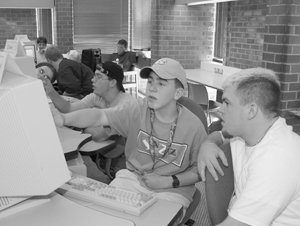Computer-Mediated Communication
Mentor, peer, and near-peer relationships have the potential to provide students with disabilities with psychosocial, academic, and career support, thereby lessening or eliminating some of the unique challenges they face. However, these types of relationships can be limited by physical distance, time, and schedule constraints and, in some cases, disability-related communication barriers (e.g., speech impairments, deafness).

For these relationships to be successful, it is often necessary to match young people and mentors who are in close geographic locations. Even if such relationships can be established, communication, transportation, and scheduling problems must be resolved. In short, arranging traditional in-person mentoring and peer support for this population is problematic.
Computer-mediated communication (CMC), wherein people use computers and networks to communicate with one another, makes communication across great distances and different time zones convenient, eliminating the time and geographic constraints of in-person communication. CMC facilitates the development of communities for people with common interests, regardless of their physical locations. Using electronic mail, text messaging, chat rooms, web-based forums, and other technology to sustain meaningful relationships between people who are geographically disconnected allows us to reconsider the concept of community as a physical location. The lack of social cues and social distinctions like gender, age, disability, race, and physical appearance in CMC can make even shy participants willing to share their views.
The development of computers and assistive technology makes electronic communication possible for all individuals, regardless of disability. For example, a person who is blind or has a disability that makes reading difficult can use text-to-speech software to read aloud text presented on a computer screen. An individual with limited use of his hands can use a trackball, a headstick, speech input, or an alternative keyboard to control the computer; and a person with a speech or hearing impairment may be able to participate more fully in communications when they are conducted electronically.